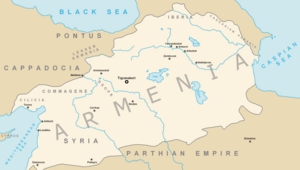History of Armenia facts for kids
The history of Armenia is super old! It goes back at least to 2000 BC. Imagine that! Experts who study ancient times, called archaeologists, have found signs of people living in the area of modern-day Armenia even earlier.
They found a very old culture, called the Shulaveri-Shomu culture, which existed around 6000 to 4000 BC. That's a long, long time ago! Even older, a tomb was found that dates back to 9000 BC. Another ancient group, the Kura-Araxes culture, lived in the Armenian Highlands from about 4000 to 2200 BC. This culture then led to the Trialeti culture (around 2200 to 1500 BC). This means that Armenians are one of the oldest groups of people who speak Indo-European languages.
Contents
Ancient Kingdoms and Peoples
The Kingdom of Urartu
Urartu was an ancient kingdom located in the Armenian Highlands. It was a powerful state before the Armenians formed their own kingdom.
Some historians believe that the Armenian people came from a mix of different groups who lived in or moved through this area. These groups included the Hurrians, the Urarteans, the Luvians, and the Mushki. The Mushki, also known as Phrygians, might have brought their Indo-European language to Armenia. Today, the Armenian language is Indo-European, but it has many words and influences from older languages, especially the Urartean language.
Armenia's Place Between Empires
In ancient times, the Armenians had friendly connections with the Parthian Empire. This was important because Armenia was located right between two huge empires: the Roman Empire and the Parthian Empire. These two empires often fought each other, and Armenia was often caught in the middle.
The Armenians played a big part in the early dealings between Rome and Parthia. A famous Armenian king named Tigranes the Great helped set up rules for how Rome and Parthia would deal with each other. The Parthians were often allies with the Armenians. Many noble families from Parthia even moved to Armenia, showing how close their ties were.
Related pages
Images for kids
-
Yerevan with Mount Ararat in the background
-
A 5500-year-old leather shoe—the oldest shoe in the world—was discovered in the Areni cave in Armenia. See Areni-1 shoe.
-
The Erivan khanate within the Iranian Safavid Empire.
-
6 Armenian provinces of Western Armenia – Patten, William and J.E. Homas, Turkey in Asia (with 6 Armenian provinces of Western Armenia), 1903
-
Map of the Armenian Oblast within the Russian Empire
-
Armenian civilians, being deported during the Armenian genocide
-
6 Armenian provinces of Western Armenia and boundaries between countries before World War I
-
The proposed Armenian state created by the Treaty of Sèvres
-
Armenian civilians fleeing Kars after its capture by Turkish forces
-
The modern concept of United Armenia as claimed by the Armenian Revolutionary Federation. Orange: areas overwhelmingly populated by Armenians (Republic of Armenia: 98%; Nagorno-Karabakh: 99%; Javakheti: 95%) Yellow: Historically Armenian areas with presently no or insignificant Armenian population (Western Armenia and Nakhichevan)
-
Inauguration of Levon Ter-Petrosyan as president in 1991
-
Military situation of Nagorno-Karabakh in May 2016
See also
 In Spanish: Historia de Armenia para niños
In Spanish: Historia de Armenia para niños

































